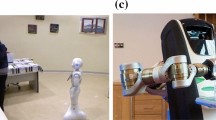Abstract
In order to inform the important considerations when designing robotic applications for public spaces, the focus of this research is to investigate what socio-psychological effects should influence robot’s decision-making within public environments. Social environments are often complex and ambiguous: many queries to the robot are collaborative (e.g. a family), but in case of conflicting queries, social robots need to participate in value decisions and negotiating multi-party interactions. With the aim to investigate who should robots adapt to (children or adults) in multi-party situations within human-robot interactions in public spaces, this paper presents a real-world study conducted in a shopping mall. The results include a number of interesting findings based on people’s relationship with a child and their parental status.
Access this chapter
Tax calculation will be finalised at checkout
Purchases are for personal use only
Similar content being viewed by others
References
SPENCER: Social situation-aware perception and action for cognitive robots. www.spencer.eu. Accessed on 8 Apr, 2015
Balkibekov, K., Meiirbekov, S., Tazhigaliyeva, N., Sandygulova, A.: Should robots win or lose? robot’s losing playing strategy positively affects child learning. In: 2016 25th IEEE International Symposium on Robot and Human Interactive Communication (RO-MAN), pp. 706–711. IEEE (2016)
Bartneck, C., Croft, E., Kulic, D.: Measurement instruments for the anthropomorphism, animacy, likeability, perceived intelligence, and perceived safety of robots. Int. J. Soc. Robot. 1(1), 71–81 (2009)
Bell, A.: Designing and testing questionnaires for children. J. Res. Nurs. 12(5), 461–469 (2007)
Belpaeme, T., Baxter, P.E., Read, R., Wood, R., Cuayáhuitl, H., Kiefer, B., Racioppa, S., Kruijff-Korbayová, I., Athanasopoulos, G., Enescu, V., Looije, R., Neerincx, M., Demiris, Y., Ros-Espinoza, R., Beck, A., Cañamero, L., Hiolle, A., Lewis, M., Baroni, I., Nalin, M., Cosi, P., Paci, G., Tesser, F., Sommavilla, G., Humbert, R.: Multimodal child-robot interaction: building social bonds. J. Hum. Robot Interact. 1(2), 33–53 (2012)
Davidoff, S., Lee, M.K., Zimmerman, J., Dey, A.: Socially-aware requirements for a smart home. In: Proceedings of the International Symposium on Intelligent Environments, pp. 41–44 (2006)
Evers, V., Menezes, N., Merino, L., Gavrila, D., Nabais, F., Pantic, M., Alvito, P., Karreman, D.: The development and real-world deployment of frog, the fun robotic outdoor guide. In: Proceedings of the 2014 ACM/IEEE International Conference on Human-robot Interaction, pp. 100–100. ACM (2014)
Foster, M.E., Gaschler, A., Giuliani, M., Isard, A., Pateraki, M., Petrick, R.P.: Two people walk into a bar: dynamic multi-party social interaction with a robot agent. In: Proceedings of the 14th ACM International Conference on Multimodal Interaction, ICMI 2012, pp. 3–10. ACM, New York (2012)
Glas, D.F., Satake, S., Ferreri, F., Kanda, T., Hagita, N., Ishiguro, H.: The network robot system: enabling social human-robot interaction in public spaces. J. Hum. Robot Interact. 1(2), 5–32 (2012)
Kanda, T., Shiomi, M., Miyashita, Z., Ishiguro, H., Hagita, N.: An affective guide robot in a shopping mall. In: Proceedings of the 4th ACM/IEEE International Conference on Human Robot Interaction, HRI 2009, pp. 173–180. ACM, New York (2009)
Kondo, Y., Takemura, K., Takamatsu, J., Ogasawara, T.: A gesture-centric android system for multi-party human-robot interaction. J. Hum. Robot Interact. 2(1), 133–151 (2013)
Leite, I., Castellano, G., Pereira, A., Martinho, C., Paiva, A.: Long-term interactions with empathic robots: evaluating perceived support in children. In: Ge, S.S., Khatib, O., Cabibihan, J.-J., Simmons, R., Williams, M.-A. (eds.) ICSR 2012. LNCS, vol. 7621, pp. 298–307. Springer, Heidelberg (2012). doi:10.1007/978-3-642-34103-8_30
Lidoris, G., Bauer, K.K.A., Xu, T., Kuhnlenz, K., Wollherr, D., Buss, M.: The autonomous city explorer project: aims and system overview. In: 2007 IEEE/RSJ International Conference on Intelligent Robots and Systems, pp. 560–565, Oct 2007
Makatchev, M., Simmons, R., Sakr, M., Ziadee, M.: Expressing ethnicity through behaviors of a robot character. In: Proceedings of the 8th ACM/IEEE International Conference on Human-robot Interaction, HRI 2013, pp. 357–364. IEEE Press, Piscataway, (2013)
Markopoulos, P., Read, J., MacFarlane, S., Hoysniemi, J.: Evaluating Children’s Interactive Products: Principles and Practices for Interaction Designers. Interactive Technologies. Elsevier Science, Amsterdam (2008)
Martinson, E., Lawson, W., Trafton, J.: Identifying people with soft-biometrics at fleet week. In: 2013 8th ACM/IEEE International Conference on Human-Robot Interaction (HRI), pp. 49–56 (2013)
Mussakhojayeva, S., Zhanbyrtayev, M., Agzhanov, Y., Sandygulova, A.: Who should robots adapt to within a multi-party interaction in a public space? In: The Eleventh ACM/IEEE International Conference on Human Robot Interaction, pp. 483–484. IEEE Press (2016)
Read, J., MacFarlane, S., Casey, C.: Endurability, engagement and expectations: measuring children’s fun. Interaction Design and Children, vol. 2, pp. 1–23. Shaker Publishing, Eindhoven (2002)
Salem, M., Ziadee, M., Sakr, M.: Marhaba, how may i help you?: Effects of politeness and culture on robot acceptance and anthropomorphization. In: Proceedings of the 2014 ACM/IEEE International Conference on Human-Robot Interaction, HRI 2014, pp. 74–81. ACM, New York (2014)
Sandygulova, A., Dragone, M., O’Hare, G.M.: Real-time adaptive child-robot interaction: age and gender determination of children based on 3D body metrics. In: 2014 RO-MAN: The 23rd IEEE International Symposium on Robot and Human Interactive Communication, pp. 826–831, Aug 2014
Sandygulova, A., Swords, D., Abdel-Naby, S., O’Hare, G.M., Dragone, M.: A study of effective social cues within ubiquitous robotics. In: Proceedings of the 8th ACM/IEEE International Conference on Human-Robot Interaction, HRI 2013, pp. 221–222. IEEE Press, Piscataway (2013)
Shiomi, M., Kanda, T., Ishiguro, H., Hagita, N.: Interactive humanoid robots for a science museum. In: Proceedings of the 1st ACM SIGCHI/SIGART Conference on Human-robot Interaction, HRI 2006, pp. 305–312. ACM, New York (2006)
Shiomi, M., Sakamoto, D., Kanda, T., Ishi, C., Ishiguro, H., Hagita, N.: Field trial of a networked robot at a train station. Int. J. Soc. Robot. 3(1), 27–40 (2011)
Simmons, R., Makatchev, M., Kirby, R., Lee, M.K., Fanaswala, I., Browning, B., Forlizzi, J., Sakr, M.: Believable robot characters. AI Mag. 32(4), 39–52 (2011)
A-E. Team. The ALIZ-E project: adaptive strategies for sustainable long-term social interaction. Presented as a Poster at KI 2012 (2012)
Author information
Authors and Affiliations
Corresponding author
Editor information
Editors and Affiliations
Rights and permissions
Copyright information
© 2017 Springer International Publishing AG
About this paper
Cite this paper
Mussakhojayeva, S., Kalidolda, N., Sandygulova, A. (2017). Adaptive Strategies for Multi-party Interactions with Robots in Public Spaces. In: Kheddar, A., et al. Social Robotics. ICSR 2017. Lecture Notes in Computer Science(), vol 10652. Springer, Cham. https://doi.org/10.1007/978-3-319-70022-9_74
Download citation
DOI: https://doi.org/10.1007/978-3-319-70022-9_74
Published:
Publisher Name: Springer, Cham
Print ISBN: 978-3-319-70021-2
Online ISBN: 978-3-319-70022-9
eBook Packages: Computer ScienceComputer Science (R0)




